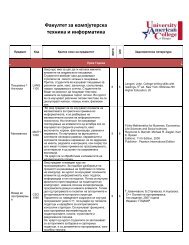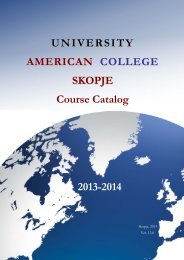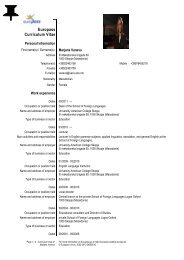UACS Collection of Abstracts 2011 - University American College ...
UACS Collection of Abstracts 2011 - University American College ...
UACS Collection of Abstracts 2011 - University American College ...
Create successful ePaper yourself
Turn your PDF publications into a flip-book with our unique Google optimized e-Paper software.
KeywordsJEL classificationeffect <strong>of</strong> the income‐tax wedge is found insignificant. Moreover, theestimates about the gross‐wage concept and the associated measures, lendsome evidence that the reform affected the transferring <strong>of</strong> a part <strong>of</strong> theinformal into formal employment, hence most likely shrinking the greyeconomy in the country.flat tax, social contributions reform, labour demand modelЈ23, Ј32Author(s)Journal <strong>of</strong> paperappearanceConference <strong>of</strong> paperappearanceTitle <strong>of</strong> the paperAbstractKeywordsJEL classificationNikica Mojsoska‐Blazevski, Marjan PetreskiReforms and Economic Development in Transition: Serbia and WesternBalkan, Belgrade, May 7, <strong>2011</strong>The Intra‐regional Trade as a Milestone for the New Growth in SEEThe Great Recession <strong>of</strong> 2007‐2009 has proved the non‐sustainability <strong>of</strong> the“growth model” that relied on expansion <strong>of</strong> domestic demand throughrapid credit growth, remittances, and FDI injections, as well as on increasedexports mainly due to favorable terms <strong>of</strong> trade and strong global demand(Bartlett and Monastiriotis, 2010). But, what would be the new and,arguably, the better growth model? According to Sanfey and Zeh (2010),greater openness and expanding trade could be part <strong>of</strong> the new growthmodel for South Eastern European economies (SEE). This especially holdsfor the intra‐regional trade that has been very low so far, with CEFTA‐2006playing a little role in expanding the intra‐regional trade.Hence, the objective <strong>of</strong> this paper is to empirically examine thedeterminants <strong>of</strong> bilateral trade <strong>of</strong> Macedonia, with particular emphasis onthe trade with the EU and CEFTA‐2006 countries. The standard Gravitymodel is used to measure the determinants <strong>of</strong> the bilateral trade in a panelframework. Results suggest that Macedonian GDP per capita and foreignGDP per capita play significant role in explaining bilateral trade. WhenMacedonian trade with EU is investigated only, then domestic income haslarger magnitude than compared to the entire sample. Importantly, noadditional gains have been approximated from FTAs and from CEFTA‐2006,in particular. Potential explanation <strong>of</strong> this can be the still existent non‐tariffbarriers across the SEE countries, in terms <strong>of</strong> the technical, sanitary andphyto‐sanitary barriers to trade, the time and costs to export and import,improvement <strong>of</strong> infrastructure related to trade and so on.Author(s)Journal <strong>of</strong> paperappearanceNikica Mojsoska‐Blazevski, Marjan PetreskiConference <strong>of</strong> paper 6 th International Conference <strong>of</strong> the <strong>UACS</strong>, May <strong>2011</strong>16


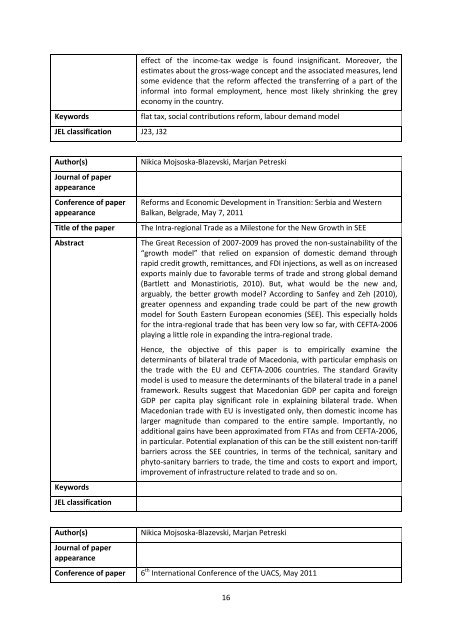
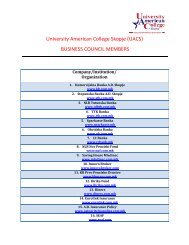

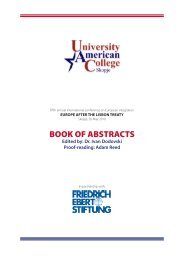

![amerikan kolex ]e bide prv univerzitet od treta generacija vo ...](https://img.yumpu.com/47278343/1/190x252/amerikan-kolex-e-bide-prv-univerzitet-od-treta-generacija-vo-.jpg?quality=85)

